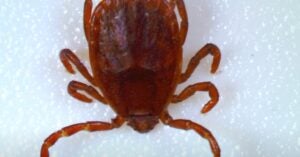Asian longhorned ticks — an invasive species that the U.S. Department of Agriculture says pose a serious threat to livestock — are now confirmed in 19 U.S. states.
Compared with well-known native ticks (such as the black-legged tick, lone star tick, and American dog tick), the Asian longhorned tick appears to be less attracted to human skin. However, first reported in the U.S. in 2017, the ticks have been found on pets, livestock, wildlife, and even some people. The female ticks are especially impressive as they reproduce without mating, and thousands may be found at a time on grass, shrubs, or animals.
Asian longhorned ticks’ secret colonization weapon is the ability to reproduce asexually, with each female laying up to 2,000 eggs at a time — and all 2,000 of those female offspring able to do the same.

Because of their ability to hide in vegetation, Asian longhorned ticks also can escape pesticides that kill only when coming into direct contact with a pest.
The Centers for Disease Control and Prevention reported in April that the ticks have now been confirmed in Arkansas, Connecticut, Delaware, Georgia, Kentucky, Maryland, Missouri, New Jersey, New York, North Carolina, Ohio, Pennsylvania, Rhode Island, South Carolina, Tennessee, Virginia, and West Virginia. The two newest states added are Indiana and Massachusetts.
Because of their ability to infest a host in such large numbers, impacted growth, performance, milk production, and even death can occur in host animals. In Ohio, one farmer noted that a healthy, male bull, of about 5 years old, was taken down by exsanguination by ticks.
While a recent experimental study found that ticks are not likely to contribute to the spread of Lyme disease bacteria in the United States, other bacteria and protozoans are a concern.
Another laboratory study found that this tick can carry and spread the bacteria that causes Rocky Mountain spotted fever (Rickettsia rickettsii). The germs that cause Rocky Mountain spotted fever have not yet been found in these ticks in nature.
Asian longhorn ticks also carry a protozoal organism called Theileria orientalis, which causes cattle disease. Theileria affects red blood cells and may destroy them, causing anemia in affected animals.
According to the USDA, it only takes one tick to create a population in a new location. Once established, control can be difficult. Because of their ability to hide in vegetation, Asian longhorned ticks also can escape pesticides that kill only when coming into direct contact with a pest.
CDC-recommended personal protective measures such as the use of EPA-approved insect repellents and 0.5 percent permethrin-treated clothing are effective against Asian longhorned ticks.

